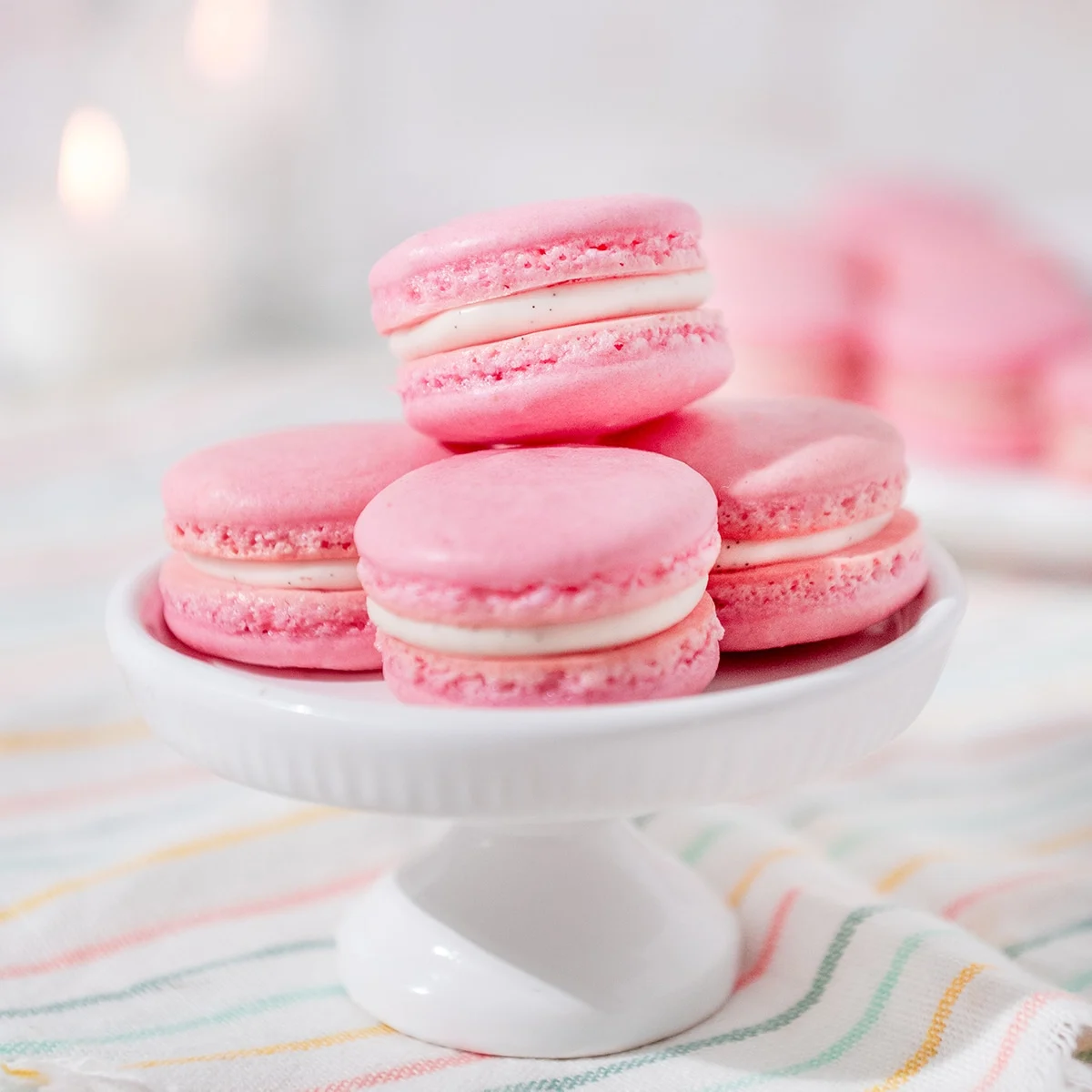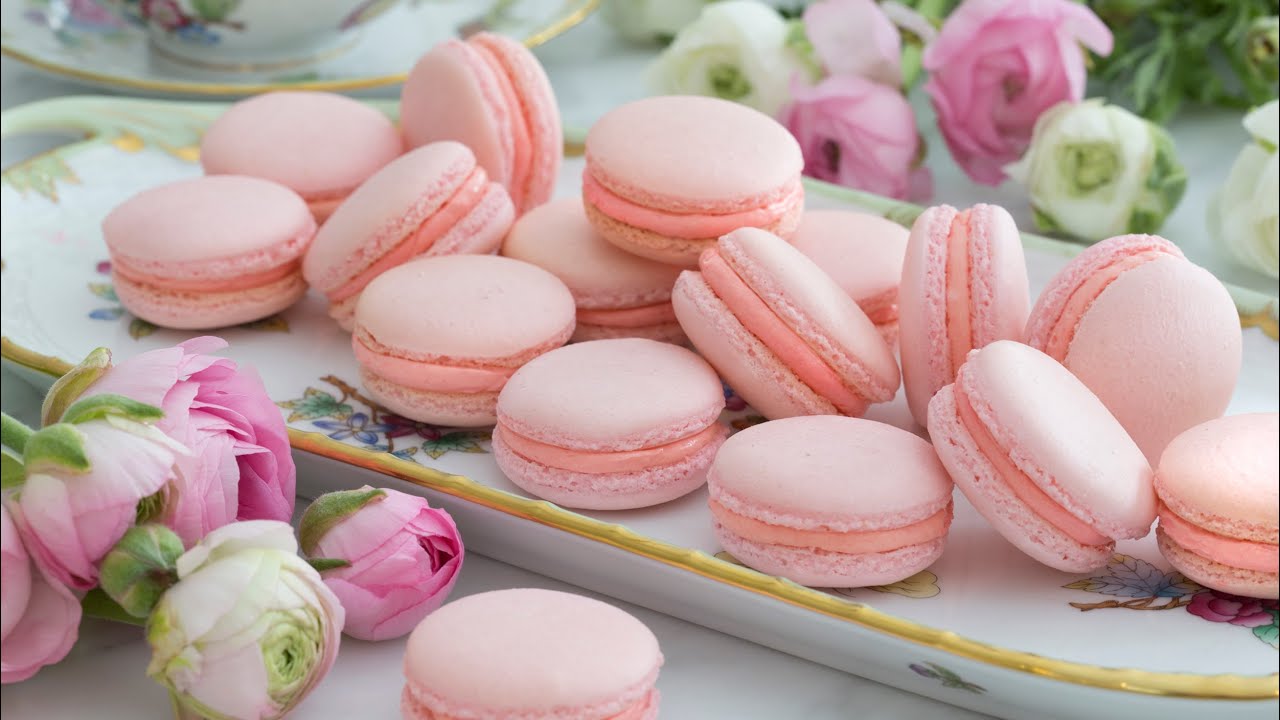
After over a decade of making macarons, I’m excited to share my complete guide to making these delicate French cookies, along with troubleshooting tips! There’s something about these fussy little confections that drives people nuts.
Macarons are my Everest, and I wasn’t going to rest until I conquered them. If you're here, you likely want to climb that macaron mountain and reach the peak of perfection! This cookie has brought me to my knees with literal tears and tantrums.
However, years of experience and a trip to France where I took a class on making them have taught me a lot about how to achieve success. While I still experience the occasional flop, it's usually due to a mistake or distraction.
1. Understanding Macarons
1.1. What Are Macarons?

French Macaron Recipe | ALL the Tips and Tricks!
Macarons are delicate French cookies known for their vibrant colors and smooth, domed tops. They are made from almond flour, egg whites, and sugar, resulting in a chewy center and a crispy exterior. Each macaron is typically filled with a flavorful filling, such as ganache, buttercream, or fruit preserves.
It’s essential to distinguish between macarons and macaroons; the former is a refined sandwich cookie, while the latter is a denser coconut-based treat. Both are gluten-free, but their flavors and texturesvary significantly.
1.2. History Of Macarons
The history of macarons can be traced back to the 16th century when they were introduced to France from Italy. Initially simple almond meringue cookies, they have evolved into the luxurious treats we know today, often associated with high-end patisseries. Over time, macarons have become a symbol of French pastry artistry, celebrated for their beauty and versatility.
2. Types Of Macaron Recipes
2.1. French Meringue Method
The French meringue method is the simplest and most accessible for beginners. It involves whipping egg whites with granulated sugar until stiff peaks form. The sugar is added gradually, making this method easy to manage with standard kitchen equipment. While this method yields decent results, it requires attention to detail to avoid over or under-whipping.
See Also: Dunkin' Donuts Signature Latte
2.2. Italian Meringue Method
The Italian meringue method is slightly more complex and involves cooking sugar with water to form a syrup, which is then poured into whipped egg whites. This technique creates a more stable meringue, resulting in macarons that are less prone to collapsing. Although it requires more steps and attention, the consistency and reliability of this method often yield superior results.
2.3. Swiss Meringue Method
The Swiss meringue method entails whisking sugar and egg whites over a double boiler until the sugar dissolves, then whipping until stiff peaks form. This method combines the benefits of the French and Italian methods, producing a stable meringue without the complexities of cooking sugar. It's an excellent option for those seeking a balance between ease and reliability.
3. Essential Ingredients
3.1. Almond Flour Vs. Almond Meal
Key Ingredient Overview:
- Almond Flour: Provides structure and flavor. It's finely ground from blanched almonds, making it lighter and smoother than almond meal.
- Almond Meal: Ground almonds with skins on; while it can be used, it results in a coarser texture and darker color.
Tips for Sourcing:
Look for good-quality almond flour at specialty grocery stores or online. Ensure it's finely ground for the best results.
3.2. Egg Whites
Fresh egg whites are essential for making macarons, as they whip up to form a stable meringue. Many bakers recommend aging egg whites by separating them from the yolks and refrigerating them for at least 24 hours. Aging helps break down the proteins, allowing for better aeration and stability during whipping.
3.3. Sugar And Cream Of Tartar
Key Functions:
- Sugar: Stabilizes the meringue and contributes to the macaron’s structure.
- Cream of Tartar: Optional; it can provide additional stability and help achieve maximum volume in the whipped egg whites.
Quick Reference:
Use superfine sugar for optimal results, as it dissolves quickly and evenly.
3.4. Food Coloring And Flavorings
Adding gel food coloring is a popular way to enhance the visual appeal of macarons. Avoid using liquid food coloring, as it can alter the batter's consistency. When flavoring the shells, use extracts or finely ground freeze-dried fruits to maintain the delicate balance of ingredients without adding excess moisture.
4. Equipment Needed
To successfully make macarons, the right equipment is essential:
- Sifter: Ensures that almond flour and powdered sugar are lump-free for a smooth batter.
- Kitchen Scale: Accurate measurements are crucial for macaron success; measuring by weight yields the best results.
- Mixer: An electric mixer is necessary for whipping egg whites to stiff peaks, saving time and effort.
- Baking Sheets: Quality, flat baking sheets are essential for even baking.
- Liners: Use either parchment paper or silicone baking mats to prevent sticking and ensure even heat distribution.
- Piping Bags and Tips: Necessary for piping the macaron batter into uniform shapes.
5. Step-by-Step Guide To Making French Macarons
5.1. Preparing Your Ingredients
Before starting, gather all your ingredients and tools. Precise measurements are vital, so use a kitchen scale to weigh your almond flour, sugar, and egg whites. Organize your workspace to streamline the process and minimize distractions.
Related: Dunkin' Donuts Packaged Teas: Ingredients, Flavors & Health Benefits
5.2. Making The Macaron Batter
- Whipping the Egg Whites: In a clean mixing bowl, whip the egg whites on medium speed until frothy. Gradually add granulated sugar, increasing the speed to high. Continue whipping until stiff peaks form, and the meringue appears glossy.
- Incorporating Almond Flour: Gently fold the sifted almond flour into the meringue using a spatula. Be careful not to deflate the mixture; the goal is to combine the ingredients without losing air.
- Achieving the Ribbon Stage: Once combined, the batter should fall off the spatula in a thick ribbon and disappear back into the bowl within about 10 seconds. This consistency is crucial for successful macarons.
5.3. Piping And Resting The Macarons
Transfer the batter to a piping bag fitted with a round tip. Pipe small circles, about 1.5 inches in diameter, onto a lined baking sheet. To ensure even shapes, consider using a template underneath the parchment. After piping, gently tap the baking sheet on the counter to release any air bubbles, then let the macarons rest for 30 to 60 minutes until they form a skin.
5.4. Baking The Macarons
Preheat the oven to 300°F (150°C). Bake the macarons for 12 to 15 minutes. Keep an eye on them; they should rise and form feet. Allow the macarons to cool completely on the baking sheet before attempting to remove them.
5.5. Filling And Assembling
Once cooled, match the macarons by size. Pipe your desired filling onto the flat side of one macaron and gently press the other half on top. Popular fillings include buttercream, ganache, and fruit preserves.
6. Storing And Serving Macarons
To maintain freshness, store macarons in an airtight container in the refrigerator for up to a week. Allow them to reach room temperature before serving to enhance their flavor and texture. For longer storage, macarons can be frozen for up to a month; just ensure they are properly packaged to prevent freezer burn.
7. Troubleshooting Common Macaron Issues
| Issue Causes | Solutions |
| Cracked Shells Not dried long enough; too much moisture. | Allow proper resting time; avoid baking on humid days. |
| Hollow Macarons Undermixed batter; overwhipped meringue. | Mix until reaching the ribbon stage; monitor meringue closely. |
| No Feet Insufficient resting time; poorly whipped meringue. | Allow adequate resting; ensure proper meringue technique. |
| Sticky Shells Underbaked; excessive humidity. | Ensure thorough baking; avoid making on humid days. |
| Uneven Baking Poorly calibrated oven; improperly piped batter. | Rotate trays halfway through baking; pipe evenly. |
7.1. Cracked Shells
Cracked shells can often result from macarons not being dried long enough or the air humidity being too high.
Solutions:
- Ensure your macarons rest adequately to form a skin before baking.
- Avoid making macarons on particularly humid days.
7.2. Hollow Macarons
Hollowness can result from undermixing the batter or overwhipping the meringue.
Solutions:
Mix until you reach the ribbon stage, and monitor the meringue closely to avoid overwhipping.
7.3. No Feet Or Small Feet
Feet not forming can indicate that the batter wasn’t allowed to rest adequately or the meringue wasn’t whipped enough.
Solutions:
Allow macarons to rest until the surface is no longer sticky and ensure proper meringue technique.
7.4. Sticky Or Difficult-to-Remove Shells
Sticky shells typically indicate underbaking or excessive humidity.
Solutions:
Ensure thorough baking and avoid making macarons on particularly humid days.
7.5. Other Common Issues
- Grainy Texture: Use finely ground almond flour and sift it properly.
- Uneven Baking: Rotate the trays halfway through baking for even heat distribution.
YouTube Video

Making French Macarons with Isabel, Founder of My French Recipe
8. Tips And Tricks For Success
- Measure Ingredients Accurately: Use kitchen scales to measure all ingredients by weight.
- Prepare Baking Trays in Advance: Cut parchment or lay down silicone mats before starting.
- Clean Mixing Bowls: Use vinegar or lemon juice to eliminate any grease that may interfere with meringue formation.
- Be Mindful of Weather: Adjust drying times and baking conditions based on humidity and temperature.
FAQs About My French Macarons
How Do I Flavor The Cookies?
Flavoring your filling is recommended to maintain the macaron's structure. You can use extracts or crushed freeze-dried fruits to enhance the filling without adding moisture.
Can I Make Macarons Without Almond Flour?
While traditional recipes use almond flour, substitutes like finely ground cashew or sunflower seed flour can be used, but this may alter the taste and texture.
Why Do My Macarons Crack?
Cracking can occur due to overmixing the batter or not allowing the macarons to rest before baking. Proper resting time and careful mixing are essential for preventing this issue.
Conclusion
Mastering the art of French macaronsis a rewarding endeavor that combines technique and creativity. Each step, from selecting the right ingredients to perfecting the baking process, contributes to the overall success of these elegant treats.
With practice and a willingness to experiment, the joy of creating and enjoying macarons becomes a delightful part of any baker’s journey. Gather your ingredients and embark on this sweet adventure your macarons await!
You Might Like: Iced Cappuccino At Dunkin’


